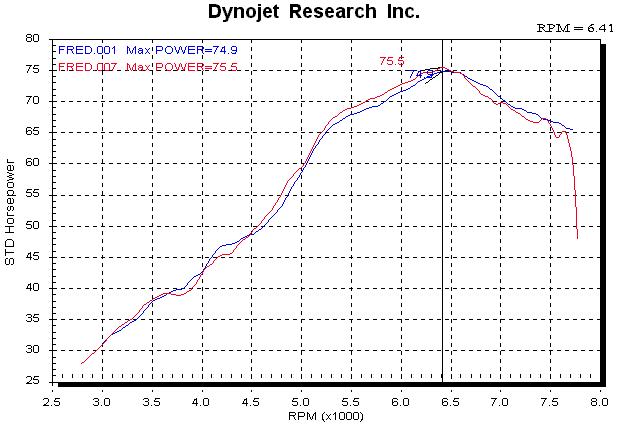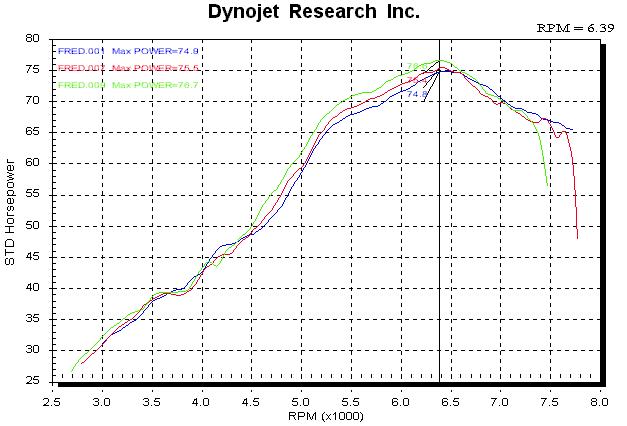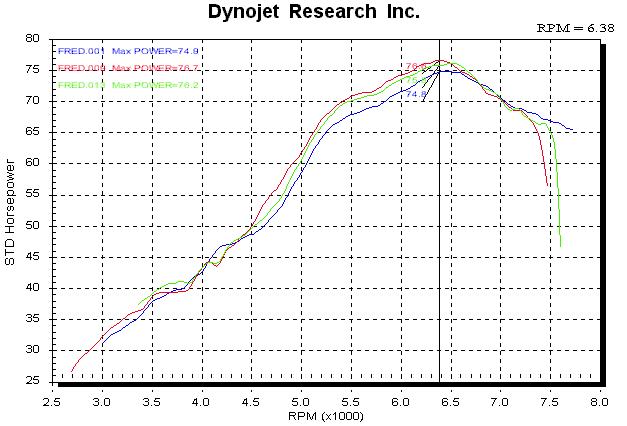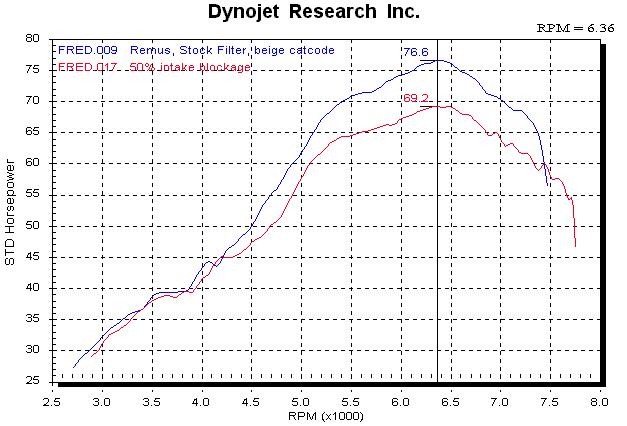|
It all started when a local club member complained about his '95 R1100R surging, and had found all the bits suggested in several articles on the web, and printed in various magazines. This tweeked my curiousity, and I decided to help the member (Fred Malley) install the parts, but do it while we had the bike on the Sun Cycle dyno. My usual co-conspirator was interested (Brian Curry), so we made a date and did the deed. Fred's bike arrived - unknown beforehand to us - with a Remus exhaust. Some research after the fact revealed that the Remus did not have a catalytic converter, but it does have a fitting for the O2 sensor and a resonator chamber where the cat would have been on a stock exhaust. We unfortunately did not have a stock exhaust to do an A-B comparison, so the disclaimer on this series of runs - the exhaust is not stock! That said - to the good part. The articles Fred had recommended replacing the pink cat-code-plug (which looks just like a relay and lives in the electrical box under the seat) with a beige one, and installing a "CO Potentiometer" - both of these are BMW parts, used on various bikes overseas. Fred came with the parts - we had the dyno. We also found when we looked - that the past-owner of Fred's bike had sprung for a K&N airfilter, so we had an additional chance to see if K&N FilterCharger did any good. Our first few runs were with the bike more or less stock (except for the Remus exhaust), and changing air-filters to see if we could find any difference:
K&N Filter (run 001) vs Stock used filter (run 003) vs no filter (run 005) If there was any difference caused by the K&N it was not measureable on the dyno - the three runs are as close as I've ever seen, and the difference is less than the error of margin for the dyno runs. Conclusion: K&N is yet again not doing anything good for the bike. Our next series of runs was done after removing the Cat-Code-Plug entirely:
Stock Pink Cat Code (001) vs NO Cat Code (007) Given the uniformity of the runs we were observing - it is possible that removing the pink cat-code plug may have resulted in a very slight power increase. We were able to get repeatable runs that overlaid the 007 run shown above. Our next try - was to install the recommended beige cat-code-plug:
Stock CCP(001), no CCP(007), Beige CCP (009) There was a measureable increase in power (repeatable runs) with the beige cat-code-plug installed. We next disconnected the O2 sensor and did another series of runs:
Stock CCP 02 sensor connected (001), Pink CCP 02 sensor connected, Pink CCP 02 sensor disconnected. There did not appear to be a real measureable difference by disconnecting the O2 sensor, making us question if the pink CCP removes the O2 sensor from the circuit. We next installed the recommended CO potentiometer:
Stock CCP 02 sensor connected (001), Beige
CCP 02 sensor connected (009), Conclusion: The pot didn't make a significant difference compared to the beige CCP without the pot installed. We reconnected the pot, and the O2 sensor, and tried one final test to see if the mixture was lean (recommended by DynoJet - but more applicable to a carburated engine without active feedback to the fuel mixture). This test was blocking 50% of the intake to the air-filter-housing (the snorkle on the R1100R.) The theory is - that the blockage will force the mixture rich, but I question if this is true on a Motronic system using an O2 sensor to adjust the mixture:
R1100R with 50% intake blockage (run 017) As noted - I believe this test is inconclusive, but the reduction in power is not 50% indicating that the R11 is not starved for intake air. Final conclusion: The owner of the bike reported back to us that the surge was gone. He seemed estatic with how the bike was now running. We ran out of time, or we had a few more ideas to try (such as the 4-prong Bosch Platinum plugs some people are recommending), but it appears from the end result - no surge, that trying the beige cat-code-plug (with or without the CO potentiometer) is a useful and inexpensive thing to try. It is also very easily reverseable if the bike has to go for warranty service.
Don Eilenberger, Brian Curry BTW - if anyone wants to advance this research, a long-term loan of an R1100R would go a long ways towards getting the job done :-) |
|





